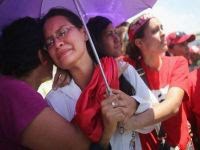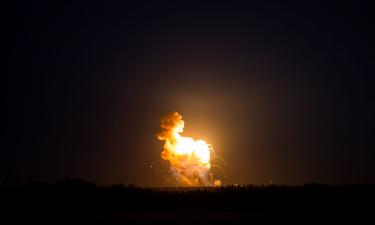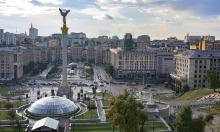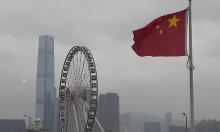Venezuela's President Hugo Chávez: a cult figure
On the 6th of March 2013, President Hugo Chávez' mortal remains were transported from the Military Hospital in Caracas to the Military Academy, where a vigil was held with family, friends, government members and international guests. The funeral car was accompanied by Vice-President, Nicolás Maduro, Minister of Foreign Affairs, Elías Jaua, and President Evo Morales from Bolivia.

by Olivia Kroth
Huge crowds had gathered along the streets and avenues, waiting to give their beloved Comandante a last greeting. The brown casket was covered with the national flag and adorned with flowers. People waved little flags or held up posters with the portrait of Hugo Chávez. Some wore T-shirts with prints of his eyes and the slogan, "Yo soy Chávez," I am Chávez.
Seen from above, the city centre looked like a huge red wave, as the crowds wore mostly red, the United Socialist Party (PSUV) colour. PSUV insignia were also visible on red caps and red shirts. As the cortege passed, the masses followed it slowly. In bird's eye view, it resembled a red dragon crawling and winding though Caracas.
The funeral train proceeded through Paseo de los Próceres, one of the main avenues with beautiful historic buildings, fountains and parks. Paseo de los Próceres is almost two kilometres long. It leads to the Military Academy, where a red carpet had already been rolled out for the coffin of President Chávez.
On Paseo de los Próceres, some impressive statues remind the public of Venezuela's anti-colonial past. The heroes of independence wars are lined up in bronze, for example Simón Bolívar, Francisco de Miranda, José Antonio Páez, José Félix Ribas and others. A relief shows the four independence battles of Ayacucho, Boyacá, Carabobo and Pichincha.
The Military Academy displays a neo-classical facade of the 1930s. For the last stretch leading to this building, Venezuelan cavalry accompanied the funeral train. A member of Guards walked in front, holding up the sword of Simón Bolívar. After seven hours, the coffin finally reached its destination, as the sun set over Caracas and the tropical heat subsided.
Inside the Hall of Honour, the Argentine President, Cristina Fernández de Kirchner, Bolivia's President, Evo Morales, the Uruguayan President, José "Pepe" Mujica, and his wife, Senator Lucía de Mujica, stood alongside the coffin, while the Venezuelan National Hymn was sung. Later, family members held a vigil next to the casket, first the President's children, then his mother and five brothers: Adán, Adelis, Aníbal, Argenis and Narciso Chávez. Government officials and military men followed, according to the protocol.
Afterwards, all the people from outside had a chance of taking a last look at the President in his open burial case, which was covered by a glass plate. His face showed a serene expression, almost smiling, as if he wanted to say: "Do not despair, my dear compatriots and comrades! Life goes on, so does the Bolivarian Revolution. Please do not forget to give Nicolás Maduro your vote in the upcoming presidential elections. Thank you and good-bye. Hasta la victoria siempre."
The Venezuelan women dedicated their special day, the 8th of March, International Women's Day, to President Chávez, as Nancy Pérez, the Minister for Equality and Gender Affairs, informed. She pointed out that Hugo Chávez increased the "visibility of women" in Venezuela. Many women reached high posts during his presidency, for example Nicolás Maduro's wife, Attorney General of the Republic, Cilia Flores, and Prosecutor General of the Republic, Luisa Ortega Díaz.
Others were nominated as ministers: Admiral Carmen Meléndez, Minister of "Dispacho" (Presidential Office); Aloha Nunez, of Wayúu origin, Minister of Indigenous Affairs; Edmée Betancourt, Minister of Commerce; Elsa Gutiérrez Graffe, Minister of Water and Air Transport; Eugenia Sader, Minister of Health; Iris Varela, Minister of the Penitentiary System; Isis Ochoa, Minister of Municipalities; Maripili Hernández, Minister of Youth; Maryann Hanson, Minister of Primary and Secondary Education; Yadira Córdova, Minister of University Education.
Interestingly, the President's twitter account, chavezcandanga, gained 75.000 new followers after the news of his death. About one million condolence tweets were sent to chavezcandanga between the 5th and 8th of March. Most of the messages came from Venezuelans (27 percent), followed by tweets from neighbouring Colombia, Argentina, Uruguay, Mexico and overseas.
According to Tribatics, a social media monitor, 44 percent of the tweeters were teenagers between 10 and 15 years, 33 percent were 16 to 21 years, 23 percent were adults. This seems to be a sure indicator for the President's cult status. He is loved by many people, young and old, and will enter history as a great Latin American freedom fighter, like Simón Bolívar, José Marti and Ché Guevara.
A young lieutenant of the Venezuelan armed forces, Juan Escalona, sent the following tweets to his friends, while standing next to Hugo Chávez' casket in the Hall of Honour, "Here I am, in front of your coffin, together with our great people who are crying, our humble people who suffer because you left us. Father, Comandante, you are not dead, you are only resting. When I die, I will be able to go to heaven, to meet you again and continue serving you."
Twenty-one delegations and 32 presidents attended the official farewell ceremony on the 8th of March, including those who had already come early and participated in the vigil by the body. Among the guests were the Presidents, Daniel Ortega from Nicaragua, Dilma Rousseff from Brazil, Manuel Santos from Colombia, Rafael Correa from Ecuador, Raúl Castro from Cuba.
The former Presidents of Brazil, Honduras and Paraguay were also present: Luiz Inácio Lula da Silva, Manuel Zelaya and Fernando Lugo. The President of Belarus, Alexander Lukashenko, had travelled to Caracas with his young son to bid his friend, Hugo Chávez, farewell.
José "Pepe" Mujica from Uruguay said, "Death is always felt and causes pain, but when it is the death of a great freedom fighter, the pain takes on a larger dimension." Later he told Venezolana de Televisión that he found it admirable, "how people waited in line for eight hours or longer to catch a last glimpse of their adored Comandante in the coffin." The President of Uruguay emphasized that "Hugo Chávez left a colossal legacy for the coming generations."
Dilma Rousseff and Luiz Inácio Lula da Silva showed their great sadness. They expressed solidarity with the Venezuelan government and people. Dilma Rousseff said, "We recognize in Hugo Chávez a great leader, a friend of Brazil." UNASUR was represented by its General Secretary, Alí Rodríguez Araque, a former Venezuelan guerrillero of the 1960s, who had helped Hugo Chávez in the struggle against the stifling dictatorship of the 4th Republic.
Manuel Santos from Colombia pointed out Hugo Chávez' contributions to the peace process between Colombia, Venezuela and FARC, "If we have moved forward with a solid peace process, it is also thanks to the dedication and commitment of Hugo Chávez." By the way, President Manuel Santos of Colombia has been nominated as one of 259 candidates for the Nobel Peace Prize for 2013. Will he have a chance of winning?
He has not bombed any country yet, as former winners of the Nobel Peace Prize have. On the contrary, Hugo Chávez once called his good friend, Manuel Santos, a "man of peace." This might not be the best of prerogatives, however, for the Oslo Nobel Committee in NATO country Norway, which seems to follow other guidelines. What else to expect from a prize that was called after Alfred Nobel, the inventor of dynamite?
The official farewell ceremony in the Hall of Honour began with the Venezuelan Youth Orchestra and Choir Simón Bolívar, intonating the National Hymn, directed by the renowned Maestro, Gustavo Dudamel. The young musicians were dressed in black, with shawls around their necks, displaying the bright Venezuelan colours of red, blue and yellow. The military men saluted, while President Alexander Lukashenko of Belarus kept padding his tearful eyes with a white handkerchief.
President Chávez' daughters, with dark sunglasses to hide their eyes, were holding hands. Dona Elena, the President's mother, was standing straight like a soldier, although she is almost 80 years of age. Elena Frías de Chávez, born 1935, grew up in the village of San Hipólito, close to Barinas, the state capital, where she met her husband, Hugo de los Reyes Chávez, when she was 16 and he was 19. Both worked as primary school teachers for most of their lives and raised their six sons, of whom Hugo was the second born.
Venezuelan actors and sportsmen formed the Honour Guard. Alejandra Benítez, born on the 27th of July 1980, a Venezuelan fencer, who competed in the women's sabre events at the 2004, 2008 and 2012 Summer Olympics, told the press that she will always remember Hugo Chávez as the "father of Venezuelan sports." Venezolana de Televisión reported how lucky Alejandra Benítez felt, to have lived in the time of this President. "He was a magical and marvellous man, a guide, manager, trainer and supporter of Venezuelan athletes."
The Venezuelan actress, Livia Méndez, told Correo del Orinoco that she considered President Chávez as the "Messias of Venezuela." Many sectors of society were able to profit from his good deeds. "He came to save us. He honoured the artistic professions and theatre workers. The Venezuelan theatre flourished under his guidance," the actress explained. Livia Méndez can look back on a career of 35 years in Venezuelan TV, film and on stage. Her best-known role was that of Josefa Carnejo, a freedom fighter during the war of independence.
The Llanero singer, Cristóbal Jiménez, interpreted one of Hugo Chávez' favourite songs, "Corrio de Maisanta." Afterwards, the Venezuelan Symphony Orchestra Simón Bolívar, again under Maestro Gustavo Dudamel's direction, presented other Llanos themes: Fiesta en Elorza, Linda Barinas and Alma Llanera. Hugo Chávez was a Llanos man. He loved the wide grassland of his home state Barinas, its Llanero culture and music.
The religious ceremony was held by Monsenor Mario Monta, Archbishop of San Cristóbal in the Andes state of Táchira. Mario Monta was a personal friend of Hugo Chávez.
Meanwhile, in the barrios of Caracas, the poor people chanted, "Chávez was one of us." They all profited from the many social programmes, like free education and healthcare. Under his presidency, living standards in Venezuela greatly improved. In 1999, the country only produced 51 percent of its nutrition consumed, in 2012, 71 percent were produced at home. Life expectancy rose from 72 years, in 1999, to 74 years in 2012.
The rate of extreme poverty dropped from 16.6 percent, in 1999, to seven percent, in 2012. Unemployment was reduced from 14.5 percent to eight percent during this time span. The minimum salary was only 247 Bolivares, in 1999. By 2012, it had augmented 2.000 percent. More than 700.000 new homes have been built all over the country since 1999, and one million hectares of land have been given back to the indigenous peoples of Venezuela.
Infant mortality went down from 19 to 10 percent in the past 13 years. The number of children enrolled in schools rose from six million to 13 million. Five million children receive free school meals regularly, in 1999 only 250.000 children benefitted. The number of university students grew from 895.000 to 2.3 million, thanks to the Misión Ribas and Misión Sucre.
With Cuban help, the number of doctors rose from 20 to 80 per 100.000 inhabitants during the last 13 years. With Operación Milagro, founded in 2004, 1.5 million Venezuelans had free eye operations. Misión Barrio Adentro, also with Cuban help, gave 534 million free medical consultations, and 17 million patients were treated.
During Hugo Chávez' Presidency, social spending was increased by 60.6 percent, while public debts were reduced from 45 percent (of the GDP), in 1999, to 20 percent, in 2012. Venezuela withdrew from the IMF and the World Bank, paying back all of its debts. After the nationalization of the oil resources (PDVSA), all segments of society were able to benefit from the oil revenues, not only the rich.
For the first time in history, Venezuela now has its own satellites, Bolívar and Miranda. There is internet in all of the territory. All in all, the country underwent a profound transformation during the presidency of Hugo Chávez. No wonder that Venezuela, according to the annual World Happiness Report, was the second happiest Latin American country in 2012.
Because millions of Venezuelans want to pay their respects to the great leader, the government decided to extend the presentation of the casket in the Hall of Honour for another week. All citizens wishing to bid Hugo Chávez farewell will be able to enter the Military Academy in Caracas, according to information given by the former Minister of Science and Technology, Jorge Arreaza, who is acting as Interim Vice-President now.
At the end of this period, the body will be embalmed and displayed in the Museum of the Revolution, for coming generations to see. Thus, Hugo Chávez will finally have been transformed into a cult figure, similar to other world leaders, like Vladimir Lenin, Ho Chi Minh and Mao Tse Tung.
Prepared for publication by:
Lisa Karpova
Pravda.Ru
Subscribe to Pravda.Ru Telegram channel, Facebook, RSS!




